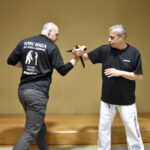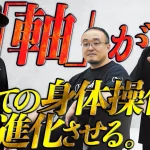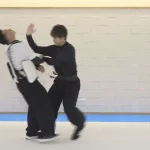Trying Samurai Combat (Armored Battle) and Bushido Class at Castle Tintagel in Tokyo.
Author: Jessica Gerrity(Instagram/Twitter @jessintokyo)
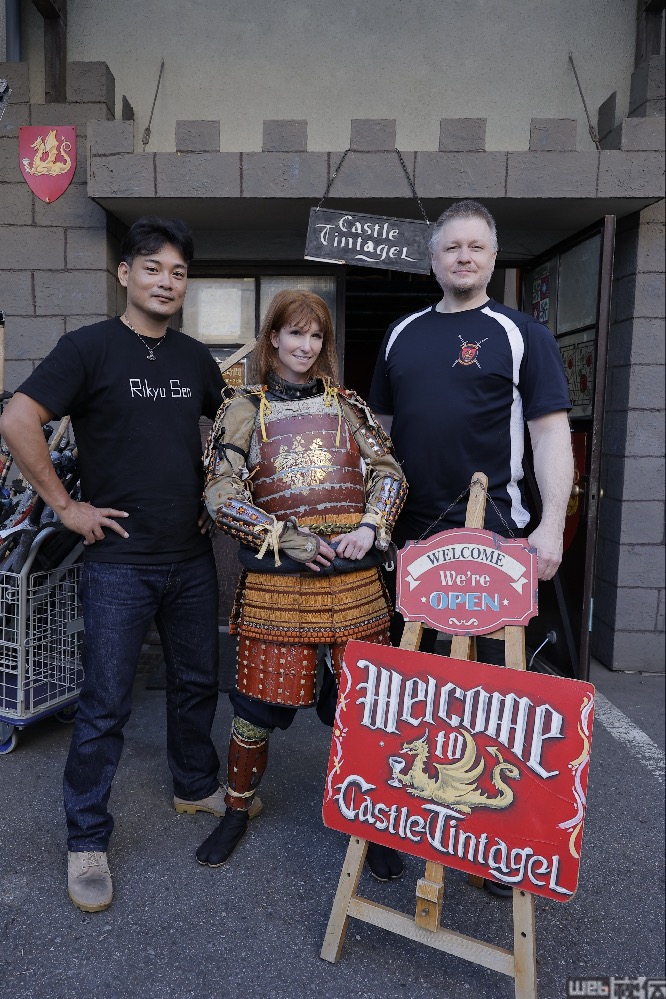
Hi everyone, this is Jessica, Budo Ambassador at Budojapan.com
Have you ever wondered about how samurai used to fight battles?
The techniques they would use, and how combat in armor would actually work?
Well I’ve ridden a horse and used a bow and arrow in armor but had never had the chance to actually try to fight in it.
I was always wondering what it would actually be like.
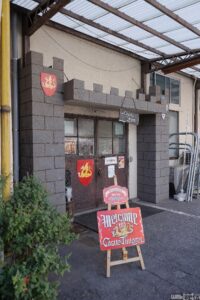 The other day I got the opportunity to try samurai combat, or armored battle at Castle Tintagel in Meijo in Tokyo.
The other day I got the opportunity to try samurai combat, or armored battle at Castle Tintagel in Meijo in Tokyo.
Located about 8 minutes from the station, this unique historical martial arts school offers Kishido or knightly martial arts training and Japanese or Bushido samurai training.
It was the first time for me to visit a facility in Japan that offered both styles. This aspect in itself is very unique.
The boss at Castle Tintagel is a man called Mr Jay Noyes and he is passionate about his work at Tintagel and with armored combat.
Together with Jay you can study Knightly Combat, both armored and unarmored. He specialises in using 15th Century longswords, spears, halberds, weapons and shields, daggers, and grappling.
Tintagel also offers a Bushido Course, which is the course I tried.

Mr Jay Noyes (right), Mr Katsumi Tanaka (left)
This course covers samurai combat, armored and unarmored. Katana, yari, naginata, tanto, and grappling.
The instructor for the class is Katsumi Tanaka san.
He has over 35 years experience in kendo, and 15 years practicing Mugai Ryu and Tendo Ryu naginatajutsu.
I tried one Bushido course kenjutsu class and then the next day joined the sparring and training session in samurai armor! If you would like to know more please keep reading!
Bushido Course, kenjutsu lesson.
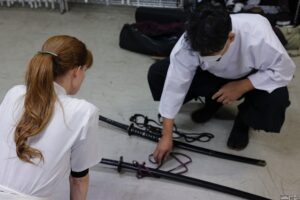
Explaining about different sword types
During my lesson with Tanaka san, he taught me about the different types of swords he uses and the names of the parts, the way the blade should face and how to hold the katana.

Showing how to draw the katana
I used a wooden sword or bokken/bokuto as this was my first lesson.
My body wasn’t used to holding a sword or doing the movements included in his training.
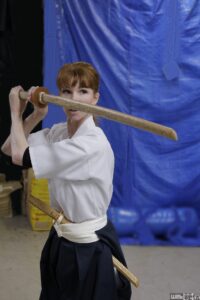
Wooden sword or bokuto
My body felt very slow and I realized that continued practice would be necessary to feel improvement.
We practiced in a unique way by using vocal cues to get the body to remember a movement.
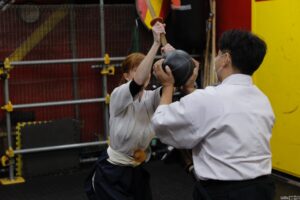
Using a medicine ball to practice control and force with a sword.
Tanaka san also teaches people who do not speak Japanese so this was a great way to get the body used to the movements of kenjutsu without having to worry about the language barrier.
I wore a tattsuke bakama/yoroi hakama for the practice as the next day I planned to fight wearing it under my armor.
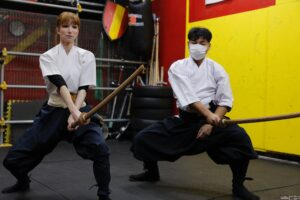
He also taught me how to walk when holding a sword and several kata.
The yoroi hakama goes slim and ties down under the knee so armor can be attached and for ease of movement.

Yoroi hakama
After several hours of sword training with Tanaka san I was totally exhausted!
But Tanaka sans personality and energy made the time pass by very quickly and it was very educational and enjoyable.
Armored Combat and Sparring.
The next day I was back again hopefully to put into practice what I had learnt in the bushido class the previous night!
After warming up with Jay I talked with him about safety during the armored battle training.
Safety
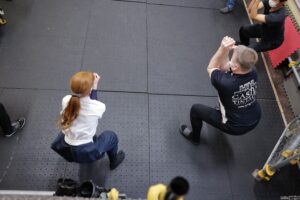
Group warm up
Safety at Castle Tintagel is of the utmost priority. Staff are fully trained and have eyes on the participants all the time.
There is a group warm up, group sparring and regular breaks which everyone takes as a group.
This helps to keep everyone at the same energy level so they can get the most out of the sparring sessions.
The sparring armor
In the case of the bushido/samurai armored battle, regular samurai armor is not strong enough and a bit of a waste to use, that is to say, it will get bent up easily during sparring and does not adequately cover the participant. Areas like hands, elbows, groin, knees, throat all get padding and armor too.

Armored gloves
While the samurai armor itself at Tintagel is thicker and custom made for actual use in battle.
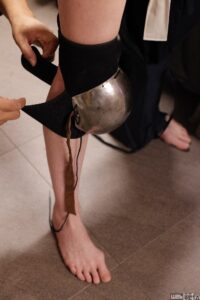
Putting on steel knee protection
The armor I wore weighed about 30kgs. The helmet or kabuto was specially designed with the menpo(face protection) attached and welded to it.
Areas around the eyes and mouth were made very small on purpose to stop handles of weapons like naginata (a bladed polearm type weapon) from penetrating the menpo and hitting my face.

The kabuto or helmet I used
However this meant my field of vision was very low and it was a challange to see around myself.
On my feet I wore safety jikatabi (Japanese style work shoes) which have hardened toes.
In the case where I get hit or trodden on I will be ok.

Getting dressed with the help of Tanaka san
The rules and codes of conduct, and safety information is given at the start of every session
Participants are given a choice to battle with an opponent at the same rank as themselves or above
There is a safe word which tells the referee and opponent a hit was scored or if the participant has had enough.
I was really impressed with Castle Tintagels attention to detail.
I got dressed in armor with the help of Tanaka san and kneepads and elbow pads were custom fitted for me.
The helmet took several attempts before it was deemed safe for use.
Careful attention was payed to the height of my head inside the helmet.

First try at sparring with Pain
It was important that if I was hit in my face, no inside parts of the helmet would touch or hit my face (they didn’t and felt very good and solid and heavy!) I was told the helmet itself weighed a good 5 or 6kg.
After getting into armor and choosing a weapon I met Pain.
Pain is a wonderful female armored battle instructor.
She went over the safe word and we started a small practice before entering the sparring area.
She invited me to hit her with my sword on her head with all my might.
Using the techniques Tanaka san had taught me the day before I swung my sword up high and hit her helmet as hard as I could.
Not hard enough! she said.
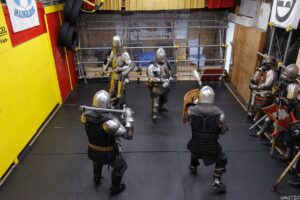
The sparring area
I tried again, however, I realized though that with each swing I was getting more and more tired!
The sheer weight of the armor and the super strengthened helmet was something I wasn’t used to!
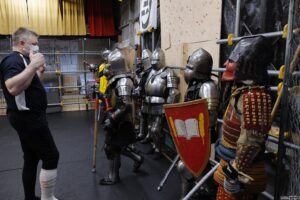
The participants lined up on one side of the sparring area and Jay the referee decided who would spar against who.
Pain san showed me what a good hit feels like, it didn’t hurt but my ears rang with the sound of the sword hitting the helmet!
It was time to go to the sparring area and start thw battle!
The sparring area is laden with thick rubber matting on the ground and the walls have wood and an area where visitors can watch the sparring and matches.
Sparring levels
 Sparring is done using several different skill sets, each one divided into Beginner and Advanced variations.
Sparring is done using several different skill sets, each one divided into Beginner and Advanced variations.
“Beginner” Rules have limited targeting (above the knees), no shield punches, and no throws or ground wrestling. “Advanced” versions let you do all of the above.
For beginners, the target areas are limited to above the knee and behind the wrist.
Strikes must have strong power, except for thrusts to the face, throat, armpit, and groin, which are “positive pressure” only. The three most popular rules sets are.
1) Basic Rules
Very simple game used for warm ups and large melees. A single strike to head or body is a victory. An arm or leg is a “wound”. The focus is on clean technique.
2) Counted Blows
This rules set focuses on aggression and staying in the fight. Strikes go to a preset number (usually 3 or 5), with no break between points.
3) Plate as Proof
In these rules, armor is factored in, and direct strikes to armor do not count for points. Usually this is combined with ground wrestling and other options to make for a very realistic fight.
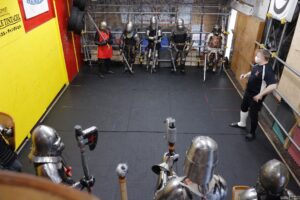
Jay divides up teams
During the sparring there was a mix of people in both knights and samurai armor which I thought was very unique!
The knights used swords and axes, spears etc while the samurai armored fighters used katana, naginata, yari etc.
In my first sparring session I was allowed to hit an opponent but he couldn’t hit me.
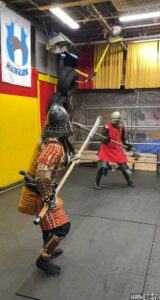
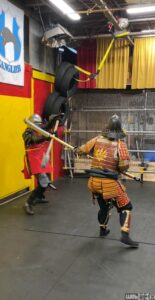 To get me used to everything, it was more difficult than I imagined but very fun.
To get me used to everything, it was more difficult than I imagined but very fun.
Next I participated in a 3 on 1 three beginners with one high level participant and I used a naginata.
This was also fun and gave me confidence.
Lastly I got to spar using a naginata with another beginner.
Physically we were a good match and she won with a tap to my head after I thought I had her beat!
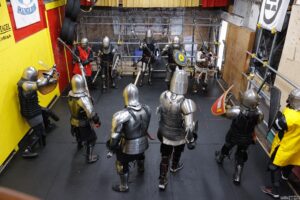 The experience of armored fighting was very interesting and made me realize just how physically fit and strong samurai must have been so long ago.
The experience of armored fighting was very interesting and made me realize just how physically fit and strong samurai must have been so long ago.
Castle Tintagel has trial lesson and lesson viewing options before you decide to join.
If you are interested to spar like a samurai please contact Jay!
Learning only kenjutsu or swordsmanship or any other weapons speciality that they offer is of course ok too.
I like the idea that the kata and techniques you build upon over time in their bushido class can be applied to their sparring and armored combat sessions.

With another samurai armored battle practitioner
It’s like having both a theory and practical aspect to your martial arts training which makes very good sense and gives you somewhere to work towards in your training at Tintagel.
The staff at Castle Tintagel are friendly and care about each participant’s ability and safety.
As a first timer I was really at ease with the kenjutsu lesson and the armored battle too.
If you are interested in trying your hand at historical martial arts, European swordsmanship, Japanese swordsmanship or putting your skills to practice in an armored battle please contact Castle Tintagel.
castletintagel
HP https://www.castletintagel.com/
Twitter https://twitter.com/castle_tintagel
Instagram https://instagram.com/castletintagel

